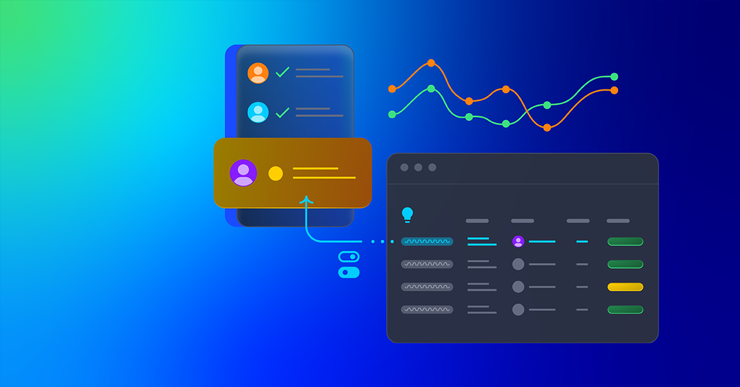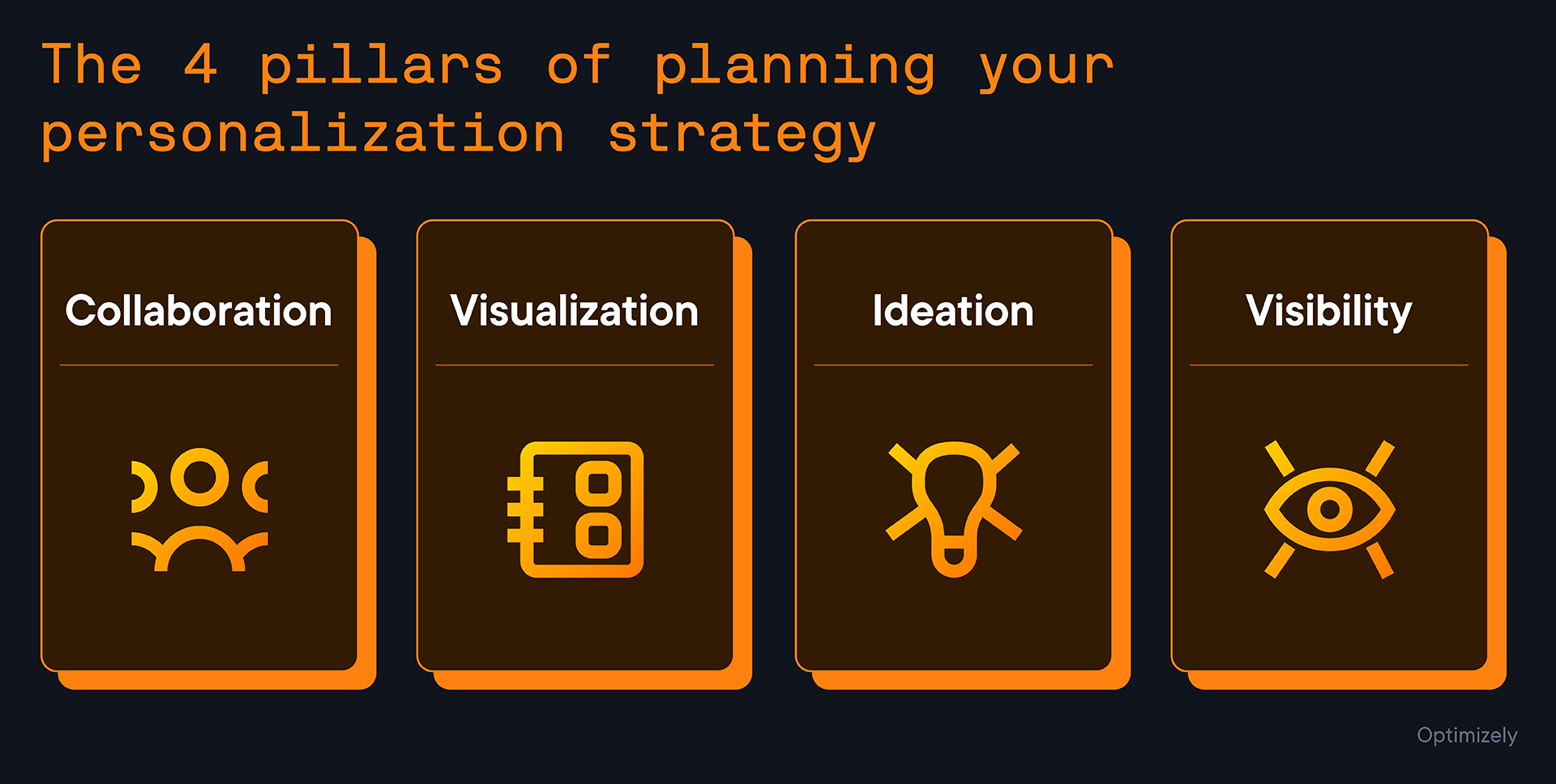Planung Ihrer Personalisierungsstrategie: Was tun, wenn niemand weiß, was zu tun ist?


Schließen Sie die Augen. Denken Sie an das letzte Mal, als Sie in einem funktionsübergreifenden Team arbeiten mussten, um ein gemeinsames Ziel zu erreichen.
Okay, jetzt öffnen Sie sie wieder.
Was haben Sie sich vorgestellt? War es so etwas wie das hier?

Das ist die kalte Realität für viele funktionsübergreifende Teams, insbesondere für diejenigen, die mit der Umsetzung einer Personalisierungsstrategie beauftragt sind. Niemand weiß, wer was tut, oder wann, oder warum, oder... irgendetwas.
In einer kürzlich von Optimizely durchgeführten Studie gaben 36 % der Führungskräfte an, dass sie durch isolierte Arbeitsabläufe von der Personalisierung abgehalten werden.
Es spielt also keine Rolle, wie viele Superhelden und Spinnenflieger Sie in Ihrem Team haben. Ohne eine einheitliche Lösung, die alle an einen Tisch bringt, werden Sie nur mit Schuldzuweisungen und (wenn Sie Glück haben) mit bunten Strumpfhosen glänzen.
Hier finden Sie einige Tipps für die Planung Ihrer Personalisierungsstrategie.
36% der Führungskräfte gaben an, dass sie durch isolierte Arbeitsabläufe von der Personalisierung abgehalten werden.
Erste Schritte zur Personalisierung
Personalisierung ist eine Verbindung von Kunst und Wissenschaft, und die wissenschaftliche Methode beginnt mit der Definition eines Problems (eigentlich beginnt sie mit Beobachtungen, aber gehen wir davon aus, dass Sie das Kundenverhalten bereits beobachtet haben).
Für die überwältigende Mehrheit der Unternehmen ist das eine so große Hürde, dass sie von der Personalisierung abgehalten werden. Tatsächlich zeigt dieselbe Studie, dass nur 26% der Marketing-, E-Commerce- und IT-Führungskräfte weltweit eine einheitliche Definition von Personalisierung in ihrem Unternehmen haben.
Wie Ihr Unternehmen Personalisierung definiert, hängt stark davon ab, was Ihr Unternehmen tut und für wen Sie es tun. Einige Tipps, die Ihnen bei der Definition von Personalisierung helfen können, sind:
- Beginnen Sie mit Ihren Personas: Sie brauchen keine Daten, um mit der Personalisierung zu beginnen, aber Sie brauchen eine klare Vorstellung von den Profilen Ihrer idealen Kunden (ICP). Eine einfache Persona-Übung hilft Ihnen sehr dabei, die Personalisierungsreise für Ihre Zielkunden zu definieren.
- Beginnen Sie mit einer breiten Zielgruppe: Wenn Sie Daten sammeln, können Sie mit der Identifizierung Ihrer breitesten Zielgruppen beginnen. Das kann so einfach sein wie ein geografischer Standort oder so detailliert wie Erstkäufer oder Stammkunden.
- Konzentrieren Sie sich auf relevante Geschäftsergebnisse: Bei der Personalisierung mag es darum gehen, das bestmögliche Erlebnis für Ihre Kunden zu schaffen, aber mit jeder Customer Journey ist auch immer ein Geschäftsziel verbunden. All diese Bemühungen um Personalisierung zielen darauf ab, Ihre Kunden zu einer bestimmten Handlung zu bewegen. Welche Handlungen möchten Sie bei bestimmten Kunden auslösen?
(Sagen Sie nicht einfach: "Wir wollen, dass sie einen Kauf tätigen", denn das ist ja klar).
Ihre Definition von Personalisierung und die Art und Weise der Umsetzung sollten davon abhängen, was Ihre Kunden in den verschiedenen Phasen des Kaufzyklus tun sollen.
Personalisierung könnte für Ihr Unternehmen bedeuten, dass Sie Ihren Nutzern die relevantesten Inhalte zur Verfügung stellen, um die Verweildauer auf der Site zu erhöhen. Dies gilt insbesondere für gemeinnützige Organisationen und NGOs.
Aber für E-Commerce-Unternehmen und Einzelhändler kann Personalisierung etwas ganz anderes bedeuten. Sie möchten vielleicht Produktempfehlungen geben und die Nutzer so schnell wie möglich zum Kauf bewegen.
Innehalten, zusammenarbeiten und zuhören
Personalisierung ist ein echter Teamsport, der eine effektive Koordination zwischen vielen verschiedenen Abteilungen erfordert. Ohne eine zentralisierte Lösung, die Zusammenarbeit, Visualisierung, Ideenfindung und Sichtbarkeit ermöglicht, wird es im Grunde nur ein riesiges Spiderman-Memo nach dem anderen werden.
Bevor Sie etwas unternehmen, müssen Sie sicherstellen, dass Sie einen gemeinsamen Arbeitsbereich haben , der eine funktionsübergreifende Planung und Zusammenarbeit ermöglicht.

-
Zusammenarbeit
Der Versuch, eine Personalisierungsstrategie ohne ein Collaboration-Tool umzusetzen, ist so, als würden Sie mit Ihren Freunden Karaoke zu einem Lied singen, das Sie noch nie gehört haben. Sicher, der Text steht direkt vor Ihnen und der Song wird hinter Ihnen abgespielt, aber wenn Sie nicht die stimmliche Bandbreite von Beyonce haben, wird es sehr offensichtlich sein, dass Sie nicht wissen, was Sie tun. Und in einer Gruppe reicht schon eine einzige Person, die das Ziel verfehlt, um die gesamte Operation zum Scheitern zu bringen.
Selbst wenn Sie eine no-code Lösung verwenden möchten, müssen Sie mit Marketing-, Produkt-, Vertriebs-, Kundenerfolgs-, Technik- und Lösungsstrategen zusammenarbeiten, um sicherzustellen, dass Ihre Personalisierung reibungslos funktioniert. -
Visualisierung
In funktionsübergreifenden Teams gibt es oft eine Sprachbarriere (und wir sprechen hier nicht von kulturellen oder geografischen Grenzen). Geben Sie einer Plattform den Vorzug, die Flexibilität bei der Visualisierung ermöglicht, damit sich jedes Team bei der Nutzung der Plattform zu Hause fühlt.
Entwickler und Solution Architects sind beispielsweise eher an Gantt-Timelines gewöhnt, während Content-Marketer vielleicht lieber einen Kalender verwenden, um ihre Arbeit zu verfolgen. -
Ideenfindung
Es ist schon schwierig genug, alle Mitarbeiter in einem gemeinsamen Arbeitsbereich zu versammeln, aber was passiert, wenn jeder seinen individuellen Beitrag leistet?
Über die Visualisierung hinaus sollte Ihr Tool einen zentralen Arbeitsbereich bieten, in dem Ideen nachverfolgt, gespeichert, umgesetzt und später wiederholt werden können.
Kommunikation und Visualisierung sind wichtige Komponenten, aber Ihre Planungslösung sollte Sie auch inspirieren. Und wenn das nicht der Fall ist, sollte es (zumindest) so einfach wie möglich sein, Ihre Inspiration zu notieren und sie mit anderen zu teilen. -
Sichtbarkeit
Apropos Weitergabe: Ihre Strategie ist praktisch nutzlos, wenn sie auf einem Laufwerk vergraben ist, auf das niemand außerhalb Ihres Teams Zugriff hat. Stellen Sie sicher, dass alle Beteiligten außerhalb des Teams, das die Personalisierung umsetzt, leicht nachvollziehen können, was vor sich geht, um Reibungsverluste zu minimieren.
Durch die Einführung einer einheitlichen Plattform für die Planungsphase der Personalisierung können Sie Personalisierungskampagnen von einem einzigen Arbeitsplatz aus strategisch planen, entwickeln und genehmigen.
Test + Learn: Experimentation
Bringen Sie Ihre Daten in Ordnung
Erinnern Sie sich, als wir sagten, dass Sie nicht mit der Planung der Personalisierung beginnen müssen? (Das ist erst ein oder zwei Minuten her).
Nun, irgendwann werden Sie Daten benötigen, wenn Sie wirklich tief in die Personalisierung von Erlebnissen einsteigen wollen, die alle Kunden erwarten.
In der oben erwähnten Studie gaben 44% der Führungskräfte an, dass komplizierte oder fragmentierte Daten eine der größten Herausforderungen darstellen, während etwa die gleiche Anzahl angab, dass ein Mangel an effektiver Analytik sie behindert. Typischerweise sind fragmentierte Daten das Ergebnis von:
- Ein Flickenteppich von Datenlösungen, die über längere Zeiträume ohne jegliche Strategie zusammengeschustert wurden
- Unmengen von unnötigen und irrelevanten Daten werden gesammelt
- Schlechte Datenverwaltungssysteme
- Niemand aggregiert und analysiert die Daten, so dass sie verwertbar sind.
Eine Möglichkeit, um sicherzustellen, dass Daten kein Problem mehr darstellen, ist eine leistungsstarke Customer Data Platform (CDP).
Anstatt alles abzureißen und mit Ihren Daten, die in zahllosen Data Warehouses und Datenwolken verstreut sind, von vorne anzufangen, nutzen Sie eine CDP, um den Überblick über die ständig anfallenden Daten zu behalten. Dies ist besonders wichtig für die Personalisierung, da Sie sicherstellen wollen, dass Sie den richtigen Kunden die richtigen Daten zur richtigen Zeit zur Verfügung stellen.
Mit einer robusten CDP können Sie sich einen vollständigen Überblick über Ihre Kunden verschaffen und unbegrenzte Zielgruppensegmente aus Ihren Daten erstellen. Sie fungiert als Steuerungs- und Kontrollzentrum für Ihren gesamten Betrieb, rationalisiert die Analysen und hilft Ihnen bei der Erstellung von Kampagnenstrategien, um Ihre anonymen Shopper in treue Kunden zu verwandeln.
Ein effektives CDP bietet einen ganzheitlichen Überblick über Ihre Kunden und erstellt automatisch Segmentierungen der Zielgruppe. Sie optimiert auch die Analysen und hilft Ihnen zu verstehen, was Ihre Kampagnen bremst.

Mehr Geld für Lösungen, mehr Probleme
Es scheint, je mehr Lösungen wir unserem Tech-Stack hinzufügen, desto weniger können wir erreichen.
Das liegt daran, dass die Lösungen oft nicht so konzipiert sind, dass sie sich leicht mit anderen Tools integrieren lassen, dass sie routinemäßig gewartet werden müssen, dass sie häufig kaputt gehen, dass sie von Anfang an nicht gut geeignet waren, dass Sie an einen 10.000-Jahres-Vertrag gebunden sind, usw. usw.
Ohne eine gewisse technologische Raffinesse wird ein aufgeblähter Tech-Stack alles verlangsamen. Das ist einer der Hauptgründe, warum 40 % der Führungskräfte angeben, dass sie Schwierigkeiten haben, ihr Programm zu skalieren, während 39 % angaben, dass sie Schwierigkeiten haben, Personalisierung in Echtzeit zu implementieren.
Ähnlich wie bei der Datenerfassung gilt: Wenn Sie sich bei der Skalierung und Implementierung auf einen Flickenteppich unterschiedlicher Systeme verlassen, werden Ihre Personalisierungs-Bemühungen wahrscheinlich ausgebremst und die negativen Erlebnisse an den Kunden weitergegeben.
Durch den frühzeitigen Aufbau eines soliden Rahmens erhalten Sie die Bausteine, die Sie benötigen, um Ihre Personalisierungsmaßnahmen effektiv zu skalieren:
- Targeting von Erlebnissen, die Conversions fördern
- Bereitstellung von dynamischen Erlebnissen in Echtzeit
- Anzeige relevanter Inhalte für die richtigen Benutzer
- Recommendations von Produkten für die richtige Zielgruppe
Rekapitulieren Sie
Personalisierung ist ein Teamsport, der sorgfältige Koordination und eine einheitliche Vision erfordert. Bevor Sie überhaupt zu den Phasen kommen, in denen Sie versuchen zu entscheiden, wie Sie die regelbasierte Personalisierung mit der KI-Personalisierung in Einklang bringen können, oder in denen Sie Lösungen auf der Basis von Flicker bewerten, müssen Sie Ihre Strategie festlegen und Ihr Team in Ordnung bringen. Keine Lösung (selbst eine so leistungsstarke wie Optimizely Personalization) kann einen Mangel an Zusammenhalt und Vision überwinden.
Wenn Sie gerade erst anfangen, in Personalisierung zu investieren, oder den gesamten Prozess grundlegend neu gestalten wollen, kann das zunächst ziemlich entmutigend wirken. Die wichtigsten Schritte sind die, die Sie zu Beginn unternehmen, um sicherzustellen, dass Sie Ihre Strategie zur Personalisierung angemessen planen, ausführen und verfeinern können.

